Search Resources
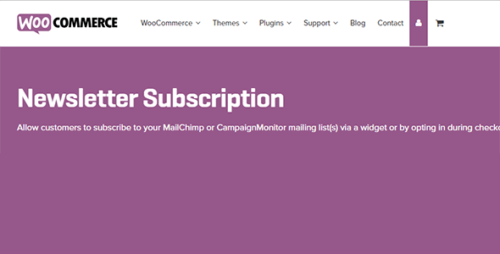
WooCommerce Newsletter Subscription 4.0.0
WooCommerce Newsletter Subscription If you run an online business using WooCommerce, you know how crucial it is to engage with your customers and keep them updated about your latest products, promotions, and news. One effective way to achieve this is by utilizing a newsletter subscription feature on your website. In this article, we will explore the importance of a WooCommerce newsletter subscription and how you can implement it to enhance your business’s growth and customer loyalty. Table of Contents Introduction: The Power of Newsletters Benefits of a WooCommerce Newsletter Subscription Setting Up a Newsletter Subscription in WooCommerce Designing an Eye-Catching Subscription Form Crafting Engaging Newsletter Content Personalization and Segmentation for Better Results Growing Your Subscriber List Analyzing Newsletter Performance Integrating with Email Marketing Services Avoiding Common Newsletter Mistakes Best Practices for Successful Newsletters Leveraging Newsletter Automation Ensuring Compliance with Data Protection Laws A/B Testing and Optimization Conclusion 1. Introduction: The Power of Newsletters Newsletters have proven to be a powerful tool for businesses to connect with their audience. They provide a direct channel of communication, allowing you to reach out to your customers, share valuable information, and build long-term relationships. With a WooCommerce newsletter subscription, you can harness this power and turn your website visitors into loyal subscribers. 2. Benefits of a WooCommerce Newsletter Subscription Implementing a newsletter subscription feature in WooCommerce brings several benefits to your business: Increased Engagement: Newsletters allow you to engage with your customers regularly, keeping them informed about your brand, products, and updates. Improved Conversion Rates: By nurturing relationships with subscribers, you can increase the likelihood of converting them into paying customers. Targeted Marketing: With a subscriber list, you can segment your audience and send personalized content tailored to their preferences, leading to higher engagement and conversion rates. Brand Building: Regular communication through newsletters helps in establishing your brand identity and increasing brand awareness. Customer Retention: Newsletters are an effective tool for retaining existing customers, encouraging repeat purchases, and fostering customer loyalty. Cost-Effective Marketing: Compared to other advertising methods, newsletters provide a cost-effective way to promote your business and drive sales. 3. Setting Up a Newsletter Subscription in WooCommerce To set up a newsletter subscription feature in WooCommerce, follow these steps: Install and activate a newsletter subscription plugin from the WooCommerce plugin directory. Configure the plugin settings, including the appearance of the subscription form, email templates, and subscriber management options. Customize the subscription form to align with your brand’s aesthetics and ensure it is user-friendly and easy to fill out. Integrate the plugin with your preferred email marketing service for seamless communication and automation. 4. Designing an Eye-Catching Subscription Form A visually appealing and well-designed subscription form can significantly impact your conversion rates. Consider the following tips when designing your form: Keep the form simple and clutter-free, asking for only essential information. Use compelling copy and persuasive language to encourage visitors to subscribe. Display the benefits of subscribing, such as exclusive offers, early access to promotions, or valuable content. Make the subscription form easily noticeable on your website, preferably above the fold. Optimize the form for mobile devices to ensure a seamless experience for mobile users. 5. Crafting Engaging Newsletter Content The success of your newsletter largely depends on the quality and relevance of the content you deliver. Here are some tips for crafting engaging newsletter content: Keep the content concise, informative, and visually appealing. Include a mix of different types of content, such as product updates, industry news, how-to guides, and customer success stories. Use captivating subject lines to increase open rates. Personalize the content based on subscribers’ preferences and purchase history. Incorporate compelling visuals and call-to-action buttons to drive engagement. Provide valuable incentives like discounts, freebies, or exclusive offers to reward your subscribers. 6. Personalization and Segmentation for Better Results Segmenting your subscriber list and personalizing your newsletters can significantly improve your campaign’s effectiveness. Consider the following segmentation criteria: Demographics: Age, location, gender, etc. Purchase Behavior: Frequency, average order value, product preferences, etc. Interests: Product categories, hobbies, preferences, etc. Engagement Level: Open rates, click-through rates, previous interactions, etc. By segmenting your audience and tailoring your content to each segment’s interests, you can deliver more relevant and personalized newsletters that resonate with your subscribers. 7. Growing Your Subscriber List Expanding your subscriber list is crucial for the success of your newsletter campaign. Here are some effective strategies to grow your subscriber base: Prominently display the subscription form on your website. Offer incentives like discounts, free resources, or exclusive content for subscribing. Utilize pop-up or slide-in forms to capture visitors’ attention. Leverage social media platforms to promote your newsletter and encourage sign-ups. Collaborate with influencers or industry partners to reach a wider audience. Run contests or giveaways that require email sign-ups to participate. Provide a seamless unsubscribe process to maintain subscriber trust. 8. Analyzing Newsletter Performance Regularly monitoring and analyzing your newsletter’s performance is crucial for optimizing your campaigns. Consider the following metrics: Open Rate: The percentage of subscribers who open your newsletter. Click-Through Rate (CTR): The percentage of subscribers who click on links within your newsletter. Conversion Rate: The percentage of subscribers who complete a desired action, such as making a purchase or signing up for an event. Bounce Rate: The percentage of undelivered emails due to invalid addresses or other issues. Unsubscribe Rate: The percentage of subscribers who opt-out of your newsletter. Use these metrics to identify areas of improvement, refine your content, and enhance your overall newsletter strategy. 9. Integrating with Email Marketing Services Integrating your WooCommerce newsletter subscription with an email marketing service can streamline your communication and provide advanced automation features. Popular email marketing services compatible with WooCommerce include Mailchimp, Constant Contact, and Sendinblue. Choose a service that suits your needs, set up the integration, and benefit from the additional functionalities offered by these platforms. 10. Avoiding Common Newsletter Mistakes While newsletters can be highly effective, it’s essential to avoid common mistakes that can hinder their success. Some common errors to avoid include: Sending newsletters too frequently or infrequently. Neglecting to proofread and edit your content for errors. Overloading newsletters with excessive information. Neglecting to optimize your newsletters for mobile devices. Failing to comply with data protection and privacy regulations. By avoiding these mistakes and consistently delivering valuable and well-crafted content, you can maximize the impact of your newsletter campaigns. 11. Best Practices for Successful Newsletters To ensure the success of your newsletter campaigns, follow these best practices: Set clear goals and objectives for your newsletters. Understand your target audience and tailor your content accordingly. Maintain a consistent brand voice and tone throughout your newsletters. Test different subject lines, content formats, and designs to optimize performance. Regularly clean your subscriber list to remove inactive or disengaged subscribers. Monitor industry trends and stay updated with the latest email marketing practices. Implementing these best practices will help you create engaging newsletters that resonate with your audience and drive the desired results. 12. Leveraging Newsletter Automation Automation can significantly streamline your newsletter processes and save time. Consider automating the following tasks: Welcome emails: Send automated welcome emails to new subscribers, introducing your brand and providing valuable information. Drip campaigns: Set up automated email series to nurture leads and guide them through the customer journey. Abandoned cart reminders: Automatically send reminders to customers who have abandoned their shopping carts, encouraging them to complete their purchase. Birthday or anniversary emails: Celebrate important milestones with personalized emails and exclusive offers. By leveraging automation, you can deliver timely and targeted emails without manual effort, improving efficiency and enhancing the subscriber experience. 13. Ensuring Compliance with Data Protection Laws When collecting and managing subscriber data, it’s crucial to comply with data protection laws such as the General Data Protection Regulation (GDPR) and the California Consumer Privacy Act (CCPA). Ensure that you: Obtain explicit consent from subscribers to collect and use their data. Clearly communicate your data usage and privacy policies. Provide an easy and accessible way for subscribers to unsubscribe and manage their preferences. Store subscriber data securely and protect it from unauthorized access or breaches. Regularly review and update your data protection practices to align with legal requirements. By prioritizing data protection and privacy, you can build trust with your subscribers and maintain a positive reputation. 14. A/B Testing and Optimization To continually improve your newsletter performance, conduct A/B tests to compare different elements and strategies. Some areas to test include: Subject lines: Test different lengths, tones, and personalization techniques. Call-to-action buttons: Experiment with different colors, texts, and placements. Content formats: Try variations like listicles, product showcases, or stories. Sending times: Test different days and times to determine optimal open and click-through rates. Personalization techniques: Compare the impact of different personalization approaches on engagement. By conducting A/B tests and optimizing your newsletters based on data-driven insights, you can continuously enhance their effectiveness. 15. Conclusion Implementing a WooCommerce newsletter subscription is a powerful strategy to engage with your customers, drive sales, and foster long-term relationships. By following the steps outlined in this article, you can set up an effective newsletter system, craft engaging content, grow your subscriber list, and analyze performance to optimize your campaigns. Stay consistent, deliver value, and watch your business thrive with the power of newsletters.
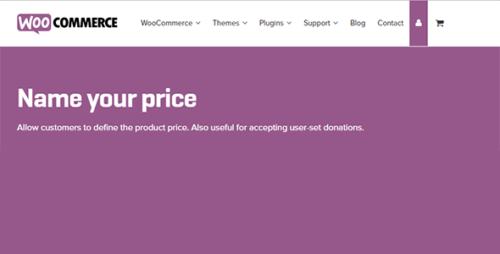
WooCommerce Name Your Price 3.5.14
WooCommerce Name Your Price: Empower Your Customers and Boost Sales In the competitive world of e-commerce, businesses are continually looking for innovative ways to attract customers and drive sales. One such approach is “WooCommerce Name Your Price,” a powerful feature that allows customers to determine the price they want to pay for a product or service. In this article, we will explore the benefits, applications, and best practices for using WooCommerce Name Your Price to leverage its full potential. What is WooCommerce Name Your Price? WooCommerce Name Your Price is an extension that enables customers to suggest a price for a product instead of being bound by a fixed price set by the store owner. It presents an opportunity for customers to express their perceived value of the item while giving merchants the flexibility to accept or reject the offered price. How Does WooCommerce Name Your Price Work? To integrate the Name Your Price feature into your WooCommerce store, follow these simple steps: Enabling the Name Your Price Feature: Go to the WooCommerce settings and click on the “Products” tab. Select “Name Your Price” from the available options and check the box to enable the feature. Setting Minimum and Maximum Limits: While giving your customers the freedom to set their price, it is essential to define a range within which they can offer prices. Set a minimum limit to ensure that the offered price is reasonable for your business and a maximum limit to prevent extremely low offers. Customizing the Display: Personalize the display of Name Your Price to match your store’s theme and aesthetics. You can add persuasive messages to encourage customers to use the feature. Benefits of Using WooCommerce Name Your Price: Implementing the Name Your Price feature can be highly advantageous for your business: Enhanced Customer Engagement: Name Your Price encourages customers to actively participate in the purchase process, fostering a sense of involvement with the brand. Increased Sales Opportunities: By allowing customers to set their prices, you open doors to potential sales that may have been lost due to fixed pricing. Building Customer Loyalty: Customers appreciate businesses that value their input, which can lead to increased loyalty and repeat purchases. Use Cases of WooCommerce Name Your Price: The Name Your Price feature can be applied in various scenarios: Non-profit Organizations: Charities and non-profits can leverage Name Your Price to allow supporters to contribute what they can afford for a cause. Product Clearance: For products with excess inventory, Name Your Price can help clear out stock by letting customers decide the price they are willing to pay. Service-Based Businesses: Service providers, such as freelancers or consultants, can use Name Your Price to accommodate clients with varying budgets. Tips to Optimize WooCommerce Name Your Price: To make the most out of the Name Your Price feature, consider these tips: Know Your Costs and Margins: Analyze your costs and profit margins before setting the minimum price to ensure that every sale remains profitable. Offer Guidance to Customers: Provide pricing suggestions or examples to guide customers, reducing the likelihood of extremely low offers. Monitor and Adjust Prices Regularly: Keep an eye on customer trends and adjust the suggested price range accordingly to optimize conversions. Common Mistakes to Avoid: While using Name Your Price, steer clear of these pitfalls: Underpricing Products: Avoid accepting offers that significantly undervalue your products, as it may lead to financial losses. Ignoring Market Trends: Stay informed about market conditions and adjust your price range accordingly to remain competitive. Conclusion: WooCommerce Name Your Price is a powerful tool that empowers both customers and business owners. By allowing customers to have a say in the price they pay, it enhances engagement, boosts sales, and fosters customer loyalty. To make the most of this feature, ensure you set appropriate limits, monitor prices regularly, and avoid common mistakes. Embrace the flexibility of Name Your Price, and watch your e-commerce store flourish with satisfied customers and increased revenue.
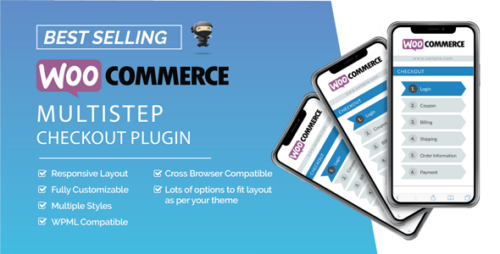
WooCommerce MultiStep Checkout Wizard 3.7.7
WooCommerce MultiStep Checkout Wizard Are you an online store owner looking to optimize your customers’ checkout experience? If so, you’ve come to the right place. In this article, we will explore the benefits and features of the WooCommerce MultiStep Checkout Wizard. By implementing this plugin, you can enhance your customers’ journey, streamline the checkout process, and ultimately boost conversions on your WooCommerce store. Table of Contents Introduction Understanding the MultiStep Checkout Concept Why Choose the WooCommerce MultiStep Checkout Wizard? Features of the WooCommerce MultiStep Checkout Wizard How to Install and Configure the Plugin Optimizing Checkout Steps for Better Conversions Enhancing User Experience with Personalization Increasing Trust and Security in the Checkout Process Monitoring and Analyzing Checkout Performance Integrations with Payment Gateways and Shipping Providers Mobile-Friendly Checkout Experience Split Testing and A/B Testing for Checkout Optimization Best Practices for Designing an Effective MultiStep Checkout Benefits of the WooCommerce MultiStep Checkout Wizard Conclusion 1. Introduction The checkout process plays a crucial role in the success of any online store. It’s the final step where your customers complete their purchase and become paying customers. However, a long and cumbersome checkout process can lead to cart abandonment and lost sales. This is where the WooCommerce MultiStep Checkout Wizard comes into play. 2. Understanding the MultiStep Checkout Concept The MultiStep Checkout concept involves breaking down the checkout process into smaller, more manageable steps. Instead of overwhelming customers with a lengthy form on a single page, the process is divided into multiple steps or pages. Each step focuses on collecting specific information, such as billing address, shipping method, and payment details. By simplifying the process and reducing cognitive load, customers are more likely to complete their purchase. 3. Why Choose the WooCommerce MultiStep Checkout Wizard? The WooCommerce MultiStep Checkout Wizard offers a user-friendly and customizable solution for implementing a MultiStep Checkout in your WooCommerce store. With this plugin, you can create a seamless and intuitive checkout experience that guides customers through each step of the process. Let’s explore some of the key features that make this plugin a top choice for online store owners. 4. Features of the WooCommerce MultiStep Checkout Wizard – Easy Installation and Configuration The WooCommerce MultiStep Checkout Wizard can be easily installed and activated on your WooCommerce store. Once activated, you can customize the plugin settings according to your store’s requirements. – Customizable Steps and Fields This plugin allows you to customize the checkout steps and fields based on your specific needs. You can add or remove steps, rearrange their order, and choose which fields to include in each step. By tailoring the checkout process to your business, you can collect the necessary information while keeping it concise. – Progress Indicator The MultiStep Checkout Wizard includes a progress indicator that visually guides customers through the checkout process. This indicator displays the current step and the overall progress, providing a clear overview of the remaining steps. It helps customers understand how far they are in the process and reduces any feelings of uncertainty. – Conditional Logic With conditional logic, you can show or hide specific fields based on customer selections or other criteria. This feature ensures a personalized experience for each customer and eliminates unnecessary fields that may not be relevant to their purchase. – Mobile-Friendly Design The plugin is designed to be mobile-responsive, ensuring a seamless checkout experience across devices. Mobile commerce is on the rise, and having a mobile-friendly checkout process is essential for capturing sales from smartphone and tablet users. – Compatibility with Payment Gateways and Shipping Providers The WooCommerce MultiStep Checkout Wizard is compatible with various payment gateways and shipping providers. Whether you use PayPal, Stripe, or another popular payment gateway, this plugin seamlessly integrates with them, ensuring a smooth and secure payment process for your customers. – Analytics and Reporting The plugin provides built-in analytics and reporting features to monitor and analyze the performance of your checkout process. You can track key metrics like cart abandonment rate, conversion rate, and average order value. This data helps you identify bottlenecks and make data-driven decisions to optimize your checkout flow. 5. How to Install and Configure the Plugin To install the WooCommerce MultiStep Checkout Wizard, follow these steps: Log in to your WordPress dashboard. Navigate to “Plugins” and click on “Add New.” Search for “WooCommerce MultiStep Checkout Wizard” in the plugin search bar. Click “Install Now” and then activate the plugin. Once activated, you can access the plugin settings under the “WooCommerce” tab in your WordPress dashboard. From there, you can customize the steps, fields, and other options according to your preferences. 6. Optimizing Checkout Steps for Better Conversions When designing your MultiStep Checkout flow, it’s essential to optimize each step for better conversions. Here are some tips to consider: Keep the number of steps to a minimum. Aim for a balance between collecting necessary information and keeping the process streamlined. Use clear and concise instructions to guide customers through each step. Avoid asking for unnecessary information that may discourage customers from completing the checkout. Enable guest checkout to cater to customers who don’t want to create an account. Provide multiple payment options to accommodate different customer preferences. Display trust symbols and security badges to instill confidence in the checkout process. 7. Enhancing User Experience with Personalization Personalization is a powerful tool in improving the overall user experience. Here are some ways you can enhance personalization in your MultiStep Checkout: Display personalized product recommendations based on the customer’s browsing or purchase history. Use dynamic content to greet customers by their name or display relevant promotions. Offer a progress-saving feature, allowing customers to resume their checkout process if they leave and come back later. 8. Increasing Trust and Security in the Checkout Process Building trust and ensuring security during the checkout process are crucial for converting visitors into customers. Consider implementing the following measures: Use SSL encryption to secure customers’ personal and payment information. Clearly display trust symbols and security badges, such as SSL seals and payment provider logos. Provide clear and transparent information about your privacy policy and data handling practices. Offer secure payment options and communicate the steps you take to protect customers’ financial information. 9. Monitoring and Analyzing Checkout Performance To continuously improve your checkout process, monitor and analyze its performance. Key metrics to track include: Cart abandonment rate: The percentage of customers who add items to their cart but leave without completing the purchase. Conversion rate: The percentage of visitors who successfully complete the checkout process. Average order value: The average amount spent by customers during checkout. Time spent on each step: Identify potential bottlenecks in the checkout flow. By analyzing these metrics, you can identify areas for improvement and test different strategies to optimize your checkout process. 10. Integrations with Payment Gateways and Shipping Providers The WooCommerce MultiStep Checkout Wizard seamlessly integrates with popular payment gateways and shipping providers. Some of the supported integrations include: PayPal Stripe Authorize.Net Square UPS FedEx USPS These integrations ensure a smooth and reliable payment and shipping experience for your customers. 11. Mobile-Friendly Checkout Experience Given the increasing number of customers shopping on mobile devices, it’s crucial to provide a mobile-friendly checkout experience. The WooCommerce MultiStep Checkout Wizard is designed to be responsive and adapt to different screen sizes. This ensures that your customers can easily navigate through the checkout process, regardless of the device they’re using. 12. Split Testing and A/B Testing for Checkout Optimization To find the most effective checkout flow for your specific audience, consider conducting split testing or A/B testing. Create multiple versions of your MultiStep Checkout, and test them with different segments of your audience. Analyze the results and make data-driven decisions to optimize your checkout flow for better conversions. 13. Best Practices for Designing an Effective MultiStep Checkout When designing your MultiStep Checkout, keep these best practices in mind: Keep the checkout process intuitive and easy to follow. Minimize distractions and unnecessary elements on each step. Use clear and descriptive labels for each field. Provide inline validation to help customers fill out the form correctly. Display a summary of the order on the final step, including items, quantities, and total cost. Implementing these best practices will help create a smooth and user-friendly checkout experience. 14. Benefits of the WooCommerce MultiStep Checkout Wizard By implementing the WooCommerce MultiStep Checkout Wizard on your WooCommerce store, you can enjoy several benefits: Increased conversions: Simplifying the checkout process and reducing cognitive load can lead to higher conversion rates. Improved user experience: A well-designed MultiStep Checkout provides a seamless and intuitive experience for your customers. Enhanced personalization: Customizing the checkout flow based on customer preferences enhances the overall shopping experience. Better data-driven decision making: The plugin’s analytics and reporting features provide valuable insights to optimize your checkout process. Compatibility with popular payment gateways and shipping providers ensures a smooth and reliable checkout experience. 15. Conclusion The WooCommerce MultiStep Checkout Wizard offers a powerful solution for enhancing the checkout experience on your WooCommerce store. By implementing a MultiStep Checkout, you can simplify the process, increase conversions, and improve customer satisfaction. With its customizable features, compatibility with payment gateways and shipping providers, and analytics capabilities, this plugin provides all the tools you need to optimize your checkout flow and boost your online store’s success.
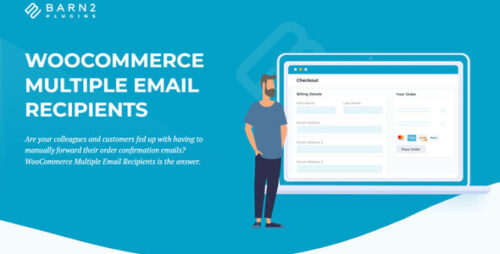
WooCommerce Multiple Email Recipients 1.2.10 By Barn2Media
WooCommerce Multiple Email Recipients: Simplifying Communication with Barn2 Media In today’s fast-paced digital era, efficient communication is the cornerstone of successful e-commerce businesses. WooCommerce, the popular WordPress plugin, has revolutionized online selling. However, one common challenge many store owners face is sending order notifications and other crucial emails to multiple recipients. Enter Barn2 Media, a solution that streamlines this process effortlessly. The Power of WooCommerce WooCommerce has established itself as a reliable and user-friendly e-commerce platform. With its myriad of features, it empowers entrepreneurs to create and manage online stores with ease. But, when it comes to email notifications, WooCommerce has some limitations. The Email Dilemma By default, WooCommerce sends order notifications and other essential emails to a single recipient – the admin email address. While this is suitable for small-scale operations, it falls short when a store requires multiple stakeholders to stay informed. The Need for Multiple Recipients Imagine a scenario where a WooCommerce store has multiple team members, each responsible for different aspects of the business. From order fulfillment to customer service, several individuals require real-time notifications to ensure seamless operations. Additionally, some store owners collaborate with external partners, such as dropshipping companies or marketing agencies. These partners too should be kept in the loop regarding order updates and customer inquiries. Barn2 Media: The Solution You Need In response to this email conundrum, Barn2 Media offers a robust solution. This WordPress plugin allows you to configure multiple email recipients effortlessly, ensuring that every crucial message reaches the right people. How Barn2 Media Simplifies WooCommerce Email Communication Let’s delve into the practical aspects of using Barn2 Media to manage multiple email recipients effectively. 1. Easy Installation Getting started with Barn2 Media is a breeze. Simply install the plugin like any other WordPress extension, and you’re on your way to simplifying your email communication. 2. Configure Recipients Seamlessly Once the plugin is activated, navigate to the settings, and you’ll find an intuitive interface for configuring multiple recipients. Add email addresses, assign specific roles, and tailor the notifications as per your business needs. 3. Enhanced Collaboration With Barn2 Media, your team members, suppliers, and partners can be instantly informed about new orders, customer inquiries, and more. This fosters collaboration and ensures that everyone is on the same page, promoting efficient operations. 4. Customizable Templates Customize email templates to match your brand’s identity and tone. You can craft personalized messages for various recipients, creating a cohesive and professional communication strategy. 5. Ensure No Message Goes Unseen Worried about important emails getting lost in crowded inboxes? Barn2 Media allows you to send copies of all WooCommerce emails to multiple recipients, eliminating the risk of vital messages going unnoticed. 6. Stay Informed, Stay Competitive In the dynamic world of e-commerce, staying informed is crucial for staying competitive. With Barn2 Media, you can ensure that everyone involved in your business receives timely updates, helping you make informed decisions and provide excellent customer service. Conclusion In a world where seamless communication is paramount, Barn2 Media emerges as a game-changer for WooCommerce store owners. By simplifying the process of configuring multiple email recipients, this plugin empowers businesses to collaborate effectively, stay informed, and provide exceptional customer service. Don’t let your email notifications be a bottleneck in your e-commerce journey. Embrace Barn2 Media and experience the ease of streamlined communication in your WooCommerce store.
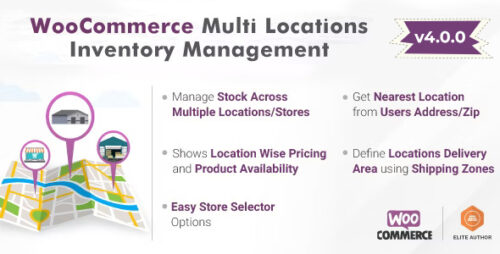
WooCommerce Multi Locations Inventory Management 4.1.0
WooCommerce Multi Locations Inventory Management: Streamline Your E-Commerce Business In today’s dynamic e-commerce landscape, managing inventory efficiently can be a challenging task. As an online store owner using WooCommerce, you need a robust solution to handle multi-location inventory management effectively. This article will guide you through the ins and outs of WooCommerce Multi Locations Inventory Management, helping you streamline your e-commerce business and ensure seamless customer experiences. Understanding the Importance of Inventory Management The Foundation of Successful E-Commerce Inventory management serves as the backbone of any successful e-commerce venture. It directly impacts your ability to meet customer demands, maintain adequate stock levels, and optimize your supply chain. Challenges of Traditional Inventory Management Traditional inventory management methods often fall short of addressing the complexities of modern e-commerce. They lack the agility required to handle multiple locations efficiently. The Role of WooCommerce WooCommerce, a popular e-commerce platform for WordPress, offers a Multi Locations Inventory Management system that addresses these challenges head-on. Setting Up Multi Locations in WooCommerce Getting Started To implement multi-location inventory management, you’ll need to configure WooCommerce properly. Adding Physical Locations Create virtual representations of your physical stores or warehouses within WooCommerce. Managing Stock Allocate stock to different locations based on demand and availability. Benefits of Multi Locations Inventory Management Enhanced Customer Experience By distributing your products strategically, you can ensure faster delivery times and lower shipping costs, delighting your customers. Inventory Optimization Avoid overstocking or understocking products by optimizing stock levels at each location. Disaster Recovery In the event of unforeseen circumstances, such as natural disasters or supply chain disruptions, having multiple locations helps you safeguard your inventory. Challenges and Solutions Inventory Synchronization Ensuring that all locations reflect real-time stock levels can be a challenge. WooCommerce provides tools for seamless inventory synchronization. Order Routing Efficiently routing customer orders to the nearest location can significantly reduce shipping costs and delivery times. Case Studies: Real-World Success Stories E-Commerce Giants Explore how industry leaders have leveraged WooCommerce Multi Locations Inventory Management to enhance their operations. Implementing Multi Locations Inventory Management Step-by-Step Guide We provide a detailed guide on how to set up and implement multi-location inventory management for your WooCommerce store. Tips for Success Best Practices Discover some best practices to maximize the benefits of multi-location inventory management while avoiding common pitfalls. Conclusion Incorporating WooCommerce Multi Locations Inventory Management into your e-commerce business is a strategic move to ensure customer satisfaction, streamline operations, and stay competitive in a rapidly evolving market. Embrace this innovative solution to take your e-commerce venture to the next level.
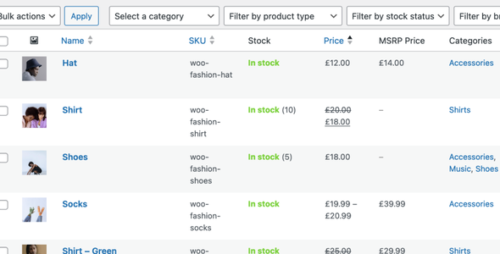
WooCommerce MSRP Pricing 3.4.24
WooCommerce Extension MSRP Pricing WooCommerce is a popular e-commerce platform that allows businesses to set up and manage online stores. One of the key features of WooCommerce is its wide range of extensions, which add functionality to the platform. In this article, we will explore the WooCommerce extension MSRP Pricing and discuss how it can benefit online store owners. Table of Contents Introduction to MSRP Pricing Why Use MSRP Pricing? Installing the MSRP Pricing Extension Configuring MSRP Pricing Displaying MSRP Prices on Product Pages Setting up Sale Prices MSRP Pricing and Dynamic Pricing MSRP Pricing and Product Variations MSRP Pricing and Product Bundles Conclusion 1. Introduction to MSRP Pricing Manufacturer’s Suggested Retail Price (MSRP) is the price recommended by the manufacturer for a product. It serves as a reference point for retailers and helps maintain price consistency across different sales channels. The MSRP Pricing extension for WooCommerce allows online store owners to display the MSRP alongside the regular price, giving customers a clear understanding of the product’s value. 2. Why Use MSRP Pricing? Using MSRP Pricing in your WooCommerce store offers several benefits. Firstly, it provides transparency to your customers by showing them the manufacturer’s suggested retail price. This helps build trust and credibility. Additionally, it allows you to highlight any discounts or promotions by displaying the difference between the regular price and the MSRP. 3. Installing the MSRP Pricing Extension To get started with MSRP Pricing, you need to install the extension on your WooCommerce store. Follow these steps: Log in to your WordPress admin panel. Navigate to “Plugins” and click on “Add New.” Search for “WooCommerce MSRP Pricing” in the search bar. Click “Install Now” next to the MSRP Pricing extension. Once the installation is complete, click “Activate.” 4. Configuring MSRP Pricing After installing the extension, you need to configure it to suit your needs. Here’s how: Go to your WooCommerce settings by clicking on “WooCommerce” in the WordPress admin sidebar. Click on the “MSRP” tab. Choose the display position for the MSRP. You can display it before or after the regular price. Set the text to appear alongside the MSRP. This could be “MSRP” or any other label you prefer. Save the changes. 5. Displaying MSRP Prices on Product Pages Once the extension is configured, you can start displaying the MSRP prices on your product pages. The MSRP will appear alongside the regular price, providing customers with valuable information about the product’s suggested retail value. 6. Setting up Sale Prices If you have sale prices for certain products, you can easily set them up using the MSRP Pricing extension. Follow these steps: Open the product editing screen in your WooCommerce admin. Scroll down to the “Product Data” section. Enter the sale price in the “Sale Price” field. Save the changes. The extension will automatically calculate the discount percentage by comparing the sale price with the MSRP and display it to the customers. 7. MSRP Pricing and Dynamic Pricing If you are using the Dynamic Pricing extension for WooCommerce, you can integrate it with MSRP Pricing. This allows you to set up dynamic pricing rules based on the MSRP, giving you more flexibility in managing your product prices. 8. MSRP Pricing and Product Variations WooCommerce allows you to create product variations with different attributes, such as size or color. With the MSRP Pricing extension, you can set different MSRP values for each product variation, providing more precise information to your customers. 9. MSRP Pricing and Product Bundles If you offer product bundles on your WooCommerce store, the MSRP Pricing extension can be used to display the combined MSRP of the bundled products. This gives customers a clear understanding of the total value they are getting with the bundle. 10. Conclusion The MSRP Pricing extension for WooCommerce is a valuable tool for online store owners who want to provide transparency to their customers and showcase the value of their products. By displaying the manufacturer’s suggested retail price, you can build trust, highlight discounts, and enhance the overall shopping experience. Install the MSRP Pricing extension today and take your WooCommerce store to the next level.
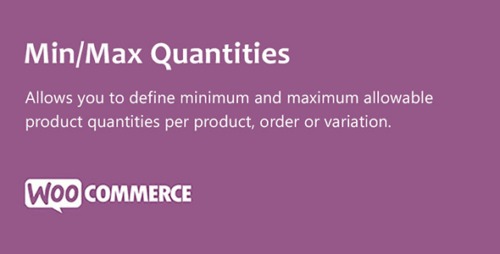
WooCommerce Min Max Quantities 5.2.5
WooCommerce Min Max Quantities: A Comprehensive Guide In the world of e-commerce, managing product quantities is crucial for maintaining a healthy inventory and providing a seamless shopping experience. WooCommerce, a popular WordPress plugin, offers a powerful feature known as Min Max Quantities. In this article, we’ll delve into the details of this feature, exploring its benefits, implementation, and best practices. Understanding Min Max Quantities What are Min Max Quantities? Min Max Quantities, as the name suggests, allows you to define the minimum and maximum purchase quantities for products in your WooCommerce store. This feature is particularly useful for businesses that sell products in bulk or want to encourage customers to purchase a certain quantity. Why are Min Max Quantities Important? Implementing Min Max Quantities ensures that customers buy products within specific quantity ranges, preventing orders that are too small or too large. This helps businesses manage their inventory effectively and prevents abuse of discounts or deals. Implementing Min Max Quantities Enabling Min Max Quantities To enable Min Max Quantities in your WooCommerce store, follow these simple steps: Access Your WooCommerce Dashboard: Log in to your WordPress admin panel and navigate to WooCommerce settings. Select Min Max Quantities: Click on the “Products” tab and then choose “Min Max Quantities” from the dropdown menu. Set Global Values: Define default minimum and maximum quantities for all products. Configuring Product-Specific Values For more precise control, you can set individual quantity limits for each product: Edit Product: Open the product you want to configure and scroll down to the Min Max Quantities section. Override Global Settings: Enable the option to “Override Global Settings” and enter product-specific minimum and maximum quantities. Best Practices for Using Min Max Quantities 1. Gradual Implementation Start with conservative quantity limits and gradually adjust them based on customer behavior. This prevents customers from feeling restricted and encourages them to adapt to the new limits. 2. Clear Communication Display the minimum and maximum quantity information on product pages. Transparent communication helps customers make informed purchasing decisions. 3. Consider Seasonal Variations Adjust quantity limits during peak seasons or promotional periods to accommodate increased demand. 4. Test User Experience Before finalizing quantity limits, conduct usability testing to ensure that the purchasing process remains smooth and intuitive. Benefits of Using Min Max Quantities 1. Inventory Management Maintain optimal stock levels by preventing overstocking or understocking of products. 2. Order Consistency Ensure consistent order sizes, making order processing and fulfillment more efficient. 3. Promotions and Bundles Encourage bulk purchases by offering discounts on larger quantities, boosting sales and revenue. Conclusion WooCommerce Min Max Quantities is an indispensable tool for maintaining control over your product inventory and enhancing the shopping experience for your customers. By setting specific quantity limits, you’ll strike a balance between efficient inventory management and customer satisfaction. Implement this feature wisely and watch your e-commerce business flourish.

WooCommerce Mix and Match Products 2.7.11
WooCommerce Mix and Match Products: A Versatile Approach to E-Commerce In the world of e-commerce, providing customers with flexibility and customization options is essential to enhance their shopping experience. WooCommerce, a popular e-commerce platform, offers a powerful feature known as “Mix and Match Products.” This feature allows online store owners to create dynamic product bundles and offer customers the freedom to choose and combine various items based on their preferences. In this article, we will explore the benefits, implementation, and tips for leveraging the WooCommerce Mix and Match Products feature to drive sales and customer satisfaction. Table of Contents Understanding WooCommerce Mix and Match Products Benefits of Using Mix and Match Products How to Set Up Mix and Match Products in WooCommerce 3.1 Installation and Activation 3.2 Configuring Mix and Match Products Best Practices for Implementing Mix and Match Products 4.1 Strategic Product Selection 4.2 Pricing and Discounts 4.3 Visual Representation 4.4 Clear Product Descriptions Maximizing Sales with Mix and Match Products 5.1 Promotional Campaigns 5.2 Upselling and Cross-selling Opportunities Examples of Successful Mix and Match Product Implementations 6.1 Fashion and Apparel Industry 6.2 Home Decor and Furnishing Common Challenges and Troubleshooting Tips 7.1 Inventory Management 7.2 Compatibility with Other Plugins Conclusion 1. Understanding WooCommerce Mix and Match Products WooCommerce Mix and Match Products is a plugin that extends the functionality of the WooCommerce platform by allowing store owners to create product bundles or “mix and match” options. This feature empowers customers to choose from a selection of products and create personalized combinations that suit their needs. Whether it’s customizing a gift set, building a tailored clothing collection, or assembling a unique furniture package, Mix and Match Products provides an interactive and engaging shopping experience. 2. Benefits of Using Mix and Match Products Integrating Mix and Match Products into your WooCommerce store offers several advantages: Increased Customer Engagement: By providing customers with the freedom to mix and match products, you encourage active participation in the shopping process, leading to higher engagement and customer satisfaction. Personalization and Customization: Mix and Match Products enable customers to tailor their purchases according to their preferences, creating a sense of ownership and uniqueness. Higher Conversion Rates: The interactive nature of Mix and Match Products can boost conversion rates as customers feel more involved and invested in their buying decisions. Upselling and Cross-selling Opportunities: With the ability to showcase related products or complementary items, you can effectively cross-sell and upsell additional products, increasing the average order value. 3. How to Set Up Mix and Match Products in WooCommerce 3.1 Installation and Activation To get started with Mix and Match Products, follow these steps: Log in to your WooCommerce WordPress admin panel. Navigate to the “Plugins” section and click on “Add New.” Search for “Mix and Match Products” in the search bar. Install and activate the plugin developed by WooCommerce. 3.2 Configuring Mix and Match Products Once the plugin is activated, you can configure Mix and Match Products by: Accessing the WooCommerce settings. Clicking on the “Products” tab and selecting “Mix and Match.” Customizing the settings to define the allowed combinations, quantity restrictions, and pricing options. 4. Best Practices for Implementing Mix and Match Products To make the most of Mix and Match Products, consider the following best practices: 4.1 Strategic Product Selection Carefully curate the selection of products available for mix and match to ensure they align with your target audience’s preferences. Choose items that are frequently purchased together or complement each other. 4.2 Pricing and Discounts Experiment with different pricing strategies to incentivize customers to explore the mix and match options. You can offer discounted bundle prices, quantity-based discounts, or even free add-ons to entice customers to create their unique combinations. 4.3 Visual Representation Invest in high-quality product images and provide visual cues to guide customers in creating their bundles. Utilize product swatches, interactive selectors, or product configurators to enhance the visual experience. 4.4 Clear Product Descriptions Accompany each product with detailed descriptions that highlight their key features and benefits. Clear and concise information helps customers make informed decisions and increases their confidence in their choices. 5. Maximizing Sales with Mix and Match Products 5.1 Promotional Campaigns Leverage the mix and match feature to run targeted promotional campaigns. Create limited-time offers, exclusive bundles, or seasonal collections to drive customer engagement and boost sales. 5.2 Upselling and Cross-selling Opportunities Recommend complementary products during the mix and match selection process. Showcase related items or offer personalized recommendations to encourage customers to add more items to their cart. 6. Examples of Successful Mix and Match Product Implementations 6.1 Fashion and Apparel Industry Clothing brands can allow customers to mix and match different garments, colors, and sizes to create their unique outfits. This approach promotes personal style and encourages customers to explore the full range of products available. 6.2 Home Decor and Furnishing In the home decor industry, offering mix and match options for furniture, cushions, and accessories enables customers to design their dream spaces. By providing a variety of combinations, you cater to different preferences and interior design aesthetics. 7. Common Challenges and Troubleshooting Tips 7.1 Inventory Management When offering mix and match products, it’s crucial to ensure accurate inventory tracking. Implement a robust inventory management system and regularly update stock levels to avoid overselling or disappointing customers with unavailable items. 7.2 Compatibility with Other Plugins Occasionally, conflicts may arise between Mix and Match Products and other WooCommerce plugins. It’s important to keep your plugins up to date and test their compatibility to prevent any potential issues. 8. Conclusion WooCommerce Mix and Match Products open up exciting possibilities for e-commerce businesses, allowing them to provide customers with unparalleled flexibility and customization. By leveraging this feature effectively, you can enhance customer engagement, boost conversions, and maximize sales. Remember to curate your product selection strategically, offer compelling discounts, provide clear visuals and descriptions, and explore promotional opportunities to create a seamless and delightful shopping experience for your customers.
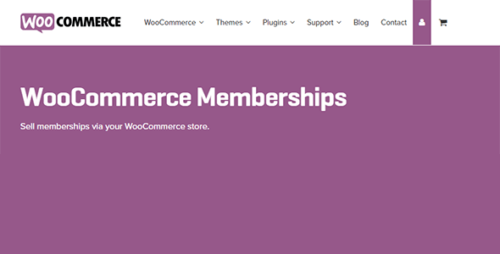
WooCommerce Memberships 1.27.2
WooCommerce Memberships: Unlock the Power of Subscription-Based Business Models Are you looking to build a thriving subscription-based business? If so, WooCommerce Memberships is the perfect solution for you. With its comprehensive features and seamless integration with the popular WooCommerce platform, this plugin enables you to create and manage membership plans, provide exclusive content to your members, and ultimately boost your revenue. In this article, we will delve into the world of WooCommerce Memberships and explore how it can transform your online business. Table of Contents Introduction to WooCommerce Memberships Setting Up Your Membership Plans Creating Exclusive Content for Members Managing Member Subscriptions Automating Renewals and Expirations Integrating WooCommerce Memberships with Other Plugins Enhancing Member Experience with Personalization Increasing Retention and Engagement Analyzing Membership Performance Optimizing SEO for Membership Sites Leveraging Marketing Strategies for Membership Growth Handling Support and Communication with Members Maintaining Data Privacy and Security Scaling Your Membership Business Conclusion 1. Introduction to WooCommerce Memberships WooCommerce Memberships is a powerful plugin designed to help businesses transform their e-commerce websites into membership-based platforms. It provides a flexible framework that allows you to offer different membership plans, control access to exclusive content, and manage member subscriptions with ease. Whether you are selling online courses, digital products, or premium services, WooCommerce Memberships empowers you to monetize your expertise and build a loyal customer base. 2. Setting Up Your Membership Plans To get started with WooCommerce Memberships, you need to define your membership plans. This involves creating different tiers or levels of membership, each with its own set of benefits and pricing. Whether you offer basic, premium, or VIP memberships, the plugin allows you to customize the duration, access levels, and pricing options to suit your business model. By providing a range of membership choices, you can cater to diverse customer needs and maximize your revenue potential. 3. Creating Exclusive Content for Members One of the key advantages of WooCommerce Memberships is the ability to offer exclusive content to your members. This could include premium articles, videos, downloadable resources, or any other type of digital content. By restricting access to this content for non-members, you create a sense of exclusivity and value, incentivizing customers to become paying members. With WooCommerce Memberships, you can easily manage content restriction and ensure that only authorized members can access your valuable resources. 4. Managing Member Subscriptions Efficiently managing member subscriptions is crucial for the success of your membership-based business. WooCommerce Memberships provides a user-friendly interface that allows you to view, edit, and update member subscriptions effortlessly. You can easily handle tasks such as adding or removing members, changing subscription levels, and monitoring payment statuses. With streamlined subscription management, you can focus on delivering exceptional member experiences and growing your community. 5. Automating Renewals and Expirations Keeping track of membership renewals and expirations can be time-consuming and prone to human error. However, with WooCommerce Memberships, you can automate these processes, saving you valuable time and ensuring uninterrupted member access. The plugin offers automated renewal reminders, allowing you to send personalized emails to members and encourage them to renew their subscriptions. Additionally, you can set up expiration grace periods, giving members a chance to renew even if their subscriptions have lapsed. 6. Integrating WooCommerce Memberships with Other Plugins WooCommerce Memberships seamlessly integrates with a wide range of other plugins, allowing you to extend its functionality and enhance your membership site. Whether you want to integrate with a learning management system, a community forum, or a content drip plugin, WooCommerce Memberships provides compatibility and flexibility. These integrations enable you to create a comprehensive membership experience that caters to your specific business requirements. 7. Enhancing Member Experience with Personalization Personalization plays a vital role in member retention and engagement. With WooCommerce Memberships, you can tailor the member experience to individual preferences and behaviors. You can offer personalized discounts, recommended content, or even create a personalized member dashboard. By providing a personalized touch, you make your members feel valued and increase their loyalty towards your brand. 8. Increasing Retention and Engagement Retaining existing members and keeping them engaged is essential for the long-term success of your membership business. WooCommerce Memberships offers various tools to help you achieve this. You can reward loyal members with exclusive perks, run special promotions, or even create a points-based system to encourage continued engagement. By continuously providing value and fostering a sense of community, you can retain members and turn them into brand advocates. 9. Analyzing Membership Performance Understanding the performance of your membership plans is crucial for making informed business decisions. WooCommerce Memberships provides detailed analytics and reporting features that allow you to track key metrics such as membership sign-ups, churn rates, and revenue growth. By analyzing this data, you can identify trends, optimize your membership offerings, and make data-driven decisions to drive the success of your business. 10. Optimizing SEO for Membership Sites Search engine optimization (SEO) is vital for driving organic traffic to your membership site. WooCommerce Memberships is built with SEO in mind, ensuring that your membership content is easily discoverable by search engines. You can optimize your membership pages with relevant keywords, meta tags, and compelling descriptions. By following best SEO practices, you can attract more potential members and increase your online visibility. 11. Leveraging Marketing Strategies for Membership Growth Effective marketing strategies are essential for attracting new members and growing your membership business. WooCommerce Memberships integrates seamlessly with popular marketing tools and platforms, allowing you to implement various marketing tactics. You can leverage email marketing campaigns, social media promotions, affiliate programs, and more to drive membership growth. By combining powerful marketing strategies with WooCommerce Memberships’ robust features, you can expand your membership base rapidly. 12. Handling Support and Communication with Members Providing exceptional customer support and maintaining clear communication with your members is crucial for building trust and satisfaction. WooCommerce Memberships offers built-in communication features that enable you to interact with your members seamlessly. You can send automated emails, provide support tickets, or even create a private community forum for your members. By establishing effective channels of communication, you can address member concerns promptly and foster a strong relationship. 13. Maintaining Data Privacy and Security As a membership-based business, ensuring the privacy and security of your members’ data is of utmost importance. WooCommerce Memberships prioritizes data protection and provides robust security features to safeguard sensitive information. The plugin is compliant with relevant data protection regulations and offers measures such as encryption, secure payment gateways, and user access controls. By prioritizing data privacy, you build trust with your members and protect your business from potential risks. 14. Scaling Your Membership Business WooCommerce Memberships is designed to scale alongside your growing business. Whether you have a small membership community or a large-scale operation, the plugin offers the flexibility and performance required to support your growth. With its robust architecture and scalability features, WooCommerce Memberships ensures that your membership site can handle increased traffic, growing membership numbers, and additional content offerings. 15. Conclusion In conclusion, WooCommerce Memberships is a powerful tool for transforming your online business into a successful subscription-based model. With its comprehensive features, easy integration with WooCommerce, and focus on member experience, this plugin empowers you to create and manage membership plans with ease. By providing exclusive content, personalizing member experiences, and optimizing your marketing strategies, you can attract, engage, and retain loyal members. Embrace the power of WooCommerce Memberships and unlock the full potential of your membership-based business.
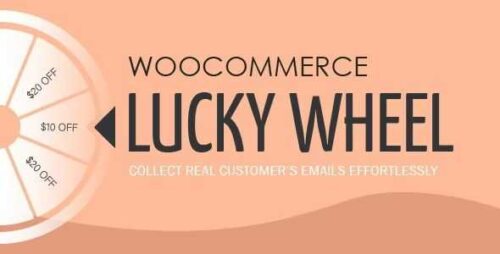
WooCommerce Lucky Wheel 1.2.10
WooCommerce Lucky Wheel: Boosting Your E-commerce Sales In the ever-evolving world of e-commerce, finding innovative ways to engage customers and increase sales is paramount. One such strategy gaining popularity is the WooCommerce Lucky Wheel. This interactive tool can help you turn your website, visitors, into loyal customers by adding an element of gamification to their shopping experience. In this article, we’ll explore how the WooCommerce Lucky Wheel can benefit your online store and provide step-by-step guidance on implementing it. 1. Introduction to WooCommerce Lucky Wheel The WooCommerce Lucky Wheel is a plugin designed to gamify the shopping experience on your e-commerce website. It allows visitors to spin a wheel to win discounts, free products, or other enticing prizes. This not only captures their attention but also encourages them to make a purchase. 2. Why Gamify Your E-commerce Store? Gamification taps into the basic human desire for fun and rewards. By incorporating a lucky wheel into your store, you create a sense of excitement and urgency, which can lead to higher conversion rates. Customers are more likely to engage with your website and make a purchase when there’s a chance to win something valuable. 3. Installing WooCommerce Lucky Wheel To get started, you’ll need to install the WooCommerce Lucky Wheel plugin on your WordPress website. It’s user-friendly and doesn’t require advanced technical skills. Simply follow the installation instructions provided by the plugin developer. 4. Configuring the Lucky Wheel After installation, configure the lucky wheel to match your brand and marketing goals. Customize the colors, fonts, and wheel segments to create an appealing visual design that aligns with your brand identity. 5. Designing an Eye-catching Wheel The success of your lucky wheel largely depends on its design. Ensure that it’s visually appealing and easy to understand. The wheel segments should display the possible prizes, enticing users to spin and win. 6. Setting Up Prizes and Discounts Decide on the prizes you want to offer, such as discounts, free products, or exclusive deals. Make sure the rewards are attractive enough to motivate visitors to participate. 7. Integrating Email Marketing Capture user email addresses when they spin the wheel. This valuable data can be used for future marketing campaigns, such as sending personalized offers and newsletters. 8. Analyzing the Results Monitor the performance of your lucky wheel. Track metrics like conversion rates, click-through rates, and the number of email sign-ups. Use this data to fine-tune your strategy for better results. 9. Tips for a Successful Lucky Wheel Keep the spinning process simple and user-friendly. Prominently display the “Spin to Win” button. Use persuasive copy to encourage participation. Rotate prizes and discounts to maintain interest. 10. Common Mistakes to Avoid Offering insignificant rewards. Neglecting mobile responsiveness. Overloading the wheel with too many segments. Forgetting to follow up with participants via email. 11. Customer Testimonials “Since implementing the WooCommerce Lucky Wheel, our sales have skyrocketed! Customers love the thrill of spinning the wheel and winning prizes.” – Sarah, E-commerce Store Owner 12. Case Studies: Real-World Success Explore how other e-commerce stores have used the lucky wheel to boost sales and engage customers. Real-world examples can provide valuable insights into its effectiveness. 13. Leveraging Social Media Promote your lucky wheel on social media platforms to reach a wider audience. Encourage social sharing to increase its visibility and generate buzz. 14. Ensuring Mobile Responsiveness In today’s mobile-driven world, your lucky wheel must be fully responsive on all devices. Ensure a seamless experience for mobile users to maximize engagement. 15. Conclusion: Spin to Win! Incorporating the WooCommerce Lucky Wheel into your e-commerce strategy can be a game-changer. By adding an element of fun and excitement, you can significantly increase customer engagement and boost sales. So, why wait? Implement the lucky wheel today and watch your online store thrive!
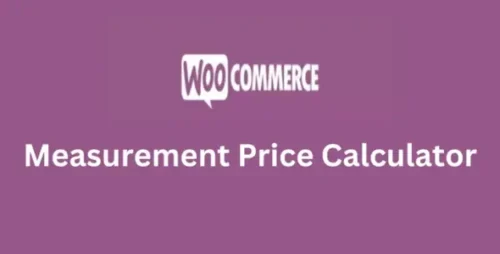
WooCommerce Measurement Price Calculator 3.23.1
WooCommerce Measurement Price Calculator: Simplify Pricing and Product Customization Are you an e-commerce business owner looking to offer personalized products with dynamic pricing options? Look no further than the WooCommerce Measurement Price Calculator plugin. This powerful tool allows you to create customizable products and calculate their prices based on various measurement units. In this article, we’ll explore the features, benefits, and implementation of the WooCommerce Measurement Price Calculator, empowering you to enhance your online store and meet the unique needs of your customers. Table of Contents Introduction What is the WooCommerce Measurement Price Calculator? Key Features Dynamic Pricing Unit-Based Pricing Customizable Formulas Multiple Measurement Units Product Customization How Does It Work? Installing the Plugin Setting Up Measurement Units Creating a Variable Product Configuring Pricing Options Use Cases Apparel and Fashion Home Improvement Printing and Signage Food and Beverage Benefits of Using WooCommerce Measurement Price Calculator Improved Customer Experience Increased Sales and Revenue Streamlined Product Management Enhanced Product Customization Tips for Effective Implementation Understand Your Products and Pricing Structure Define Clear Measurement Units Test and Optimize Conclusion 1. Introduction In the competitive world of e-commerce, offering personalized products and flexible pricing options can set your business apart from the rest. The WooCommerce Measurement Price Calculator is a versatile plugin that enables you to create custom products with dynamic pricing based on measurements. Whether you sell clothing, home improvement materials, printed goods, or food and beverages, this plugin can revolutionize your online store by simplifying the pricing process and enhancing product customization. 2. What is the WooCommerce Measurement Price Calculator? The WooCommerce Measurement Price Calculator is a plugin designed specifically for the popular WordPress e-commerce platform, WooCommerce. It allows you to create products that can be customized by customers based on their specific measurement requirements, such as size, length, weight, or volume. With this plugin, you can define different measurement units and formulas to calculate the price of each product dynamically. 3. Key Features Dynamic Pricing The plugin enables you to set up dynamic pricing rules based on the measurements provided by customers. You can define price ranges, create tiered pricing structures, or even apply percentage-based discounts. This flexibility allows you to cater to a wide range of customer needs and pricing strategies. Unit-Based Pricing With the WooCommerce Measurement Price Calculator, you can assign different prices to specific measurement units. For example, you can charge a higher rate per square meter compared to square foot measurements. This feature enables you to accommodate diverse pricing models based on the units most relevant to your products. Customizable Formulas The plugin offers customizable formulas to calculate the price based on measurements. You can create complex formulas that involve addition, subtraction, multiplication, division, and even conditional calculations. This level of customization ensures that the plugin adapts to your specific pricing requirements. Multiple Measurement Units WooCommerce Measurement Price Calculator allows you to define multiple measurement units for your products. Whether you need to offer sizes in inches, centimeters, or any other unit, this plugin has you covered. This flexibility ensures that your customers can easily choose the measurement unit that suits them best. Product Customization In addition to dynamic pricing, the plugin enables customers to customize the product itself. For example, if you sell custom-made clothing, customers can input their exact measurements and choose other options like color, fabric, or style. This level of customization enhances the user experience and helps them visualize the final product. 4. How Does It Work? Installing the Plugin To get started with the WooCommerce Measurement Price Calculator, you need to install and activate the plugin on your WordPress website. Simply navigate to the “Plugins” section in your WordPress dashboard, click on “Add New,” search for “WooCommerce Measurement Price Calculator,” and hit the “Install Now” button. Once installed, activate the plugin to begin using its features. Setting Up Measurement Units After activation, you can configure the measurement units used for your products. Go to the plugin settings, where you’ll find an intuitive interface to define and manage measurement units. Add the units relevant to your products and assign them to specific product attributes. Creating a Variable Product Next, you’ll need to create a variable product in WooCommerce. A variable product allows you to define different options and variations for a single product, such as size, color, or material. Configure the product attributes and link them to the measurement units you previously defined. Configuring Pricing Options Once you’ve set up your variable product, you can configure the pricing options using the WooCommerce Measurement Price Calculator. Define the formulas, pricing rules, and measurement dependencies to calculate the final price dynamically. Test the calculations to ensure accuracy and make adjustments if needed. 5. Use Cases The WooCommerce Measurement Price Calculator can be applied to various industries and product categories. Let’s explore some popular use cases: Apparel and Fashion Clothing retailers can utilize the plugin to offer customized garments based on customer measurements. By enabling customers to input their sizes and preferences, you can provide a truly personalized shopping experience. Home Improvement For businesses selling materials like tiles, carpets, or wallpaper, the plugin simplifies the ordering process. Customers can enter the measurements of their rooms or spaces, and the calculator will determine the precise quantity required. Printing and Signage Printing services often involve complex calculations based on print size, material, and finishing options. With the WooCommerce Measurement Price Calculator, you can automate these calculations and generate accurate quotes instantly. Food and Beverage Restaurants, bakeries, or grocery stores can benefit from the plugin by allowing customers to order customized food items or pre-packaged goods based on weight or volume. This ensures accurate pricing and avoids any confusion during the ordering process. 6. Benefits of Using WooCommerce Measurement Price Calculator Improved Customer Experience By offering customizable products and transparent pricing, you provide a superior shopping experience to your customers. They can tailor products to their specific needs, leading to higher customer satisfaction and repeat purchases. Increased Sales and Revenue Dynamic pricing and personalized product options often result in higher conversion rates. When customers can see the immediate impact of their choices on pricing, they are more likely to make a purchase. This can lead to increased sales and revenue for your online store. Streamlined Product Management The plugin simplifies the management of variable products with different options and pricing structures. It centralizes all calculations and measurement dependencies, making it easier to update and maintain your product catalog. Enhanced Product Customization With the WooCommerce Measurement Price Calculator, you can take product customization to the next level. By allowing customers to input their measurements and preferences, you provide a unique and tailored shopping experience that sets your business apart. 7. Tips for Effective Implementation To make the most of the WooCommerce Measurement Price Calculator, consider the following tips: Understand Your Products and Pricing Structure Before implementing the plugin, have a clear understanding of your products and their pricing structure. Determine the measurement units and pricing rules that align with your business model. Define Clear Measurement Units Ensure that the measurement units you define are easy for customers to understand. Avoid confusion by using commonly used units or providing clear explanations for less familiar units. Test and Optimize Thoroughly test the plugin and its calculations before launching it on your live website. Make adjustments as needed to ensure accurate pricing and a smooth user experience. 8. Conclusion The WooCommerce Measurement Price Calculator is a valuable tool for e-commerce businesses that offer customizable products with dynamic pricing. By implementing this plugin, you can enhance the user experience, increase sales, and streamline your product management process. Embrace the power of personalized pricing and product customization to stay ahead in the competitive online marketplace.
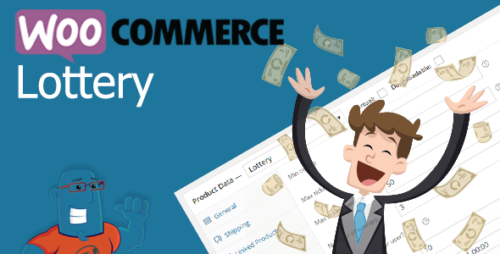
WooCommerce Lottery 2.2.6
Introduction Running a successful online store often requires innovative strategies to engage customers and boost sales. One such strategy gaining popularity is the use of WooCommerce lotteries. In this article, we will delve into the world of WooCommerce lotteries and explore how they can benefit your e-commerce business. Understanding WooCommerce Lotteries WooCommerce lotteries are a creative way to add an element of excitement to your online store. These lotteries involve offering products or services as prizes and selling tickets to customers who hope to win them. The winner is determined through a random drawing. Benefits of Running Lotteries with WooCommerce Increased Sales: Lotteries create a sense of urgency, driving customers to make purchases. Customer Engagement: It’s an interactive way to engage your audience. Marketing Opportunity: Lotteries can be used as marketing tools to promote new products. Data Collection: You can gather valuable customer information through ticket sales. Setting Up a WooCommerce Lottery To set up a WooCommerce lottery, follow these steps: Choosing the Right Lottery Plugin Select a reliable WooCommerce lottery plugin that aligns with your business needs. Some popular options include “WooCommerce Lottery” and “YITH WooCommerce Name Your Price and Lottery.” Customizing Your Lottery Customize your lottery by specifying the product or service to be won, ticket prices, and the duration of the lottery. Promoting Your WooCommerce Lottery Use various marketing channels, such as email, social media, and your website, to promote your lottery. Managing Ticket Sales Ensure a smooth ticketing process by using a reputable ticket management system or plugin. Drawing the Winner Once the lottery concludes, use a transparent method to randomly draw the winner. Document this process for transparency. Legal Considerations Be aware of local and international regulations regarding lotteries. Consult legal experts if needed to ensure compliance. Tracking and Analytics Utilize analytics tools to monitor the performance of your lottery and gain insights into customer behavior. Success Stories Share success stories of businesses that have benefited from WooCommerce lotteries to inspire your readers. Tips for a Successful WooCommerce Lottery Choose Desirable Prizes: Select prizes that resonate with your target audience. Create a Buzz: Use marketing techniques to create excitement around your lottery. Transparency: Maintain transparency in the drawing and winner selection process. Engage with Participants: Interact with ticket buyers and potential customers to build rapport. Follow Legal Guidelines: Always comply with legal regulations in your area. Common Mistakes to Avoid Lack of Promotion: Failing to market your lottery can lead to low participation. Unclear Rules: Ensure that the rules and terms of your lottery are easy to understand. Neglecting Data: Use the data collected from ticket sales to improve future lotteries. Ignoring Customer Feedback: Listen to your customers’ suggestions and complaints. Lack of Transparency: Transparency builds trust, so always be open and honest. Conclusion WooCommerce lotteries offer an exciting way to boost your e-commerce business’s sales and engage with your customers. By carefully planning and executing your lottery, you can create a buzz, drive more traffic to your website, and ultimately increase revenue.